Sendang Sono, Yogyakarta
The day before Christmas eve we visited Sendang Sono. Considered as a Catholic pilgrimage complex, it consists of small chapels and paths with carvings on altars depicting the story of Christ. Designed by the late Father Mangunwijaya its one of the most inspiring tropical sanctuaries I had ever been.
Here's abit about the now deceased Father Mangunwijaya (born Ambarawa, Semarang, 6 May 1929 - died in Jakarta 10 February 1999).
from wiki
"He is the son of Yulianus Sumadi and Serafin Kamdaniyah. At the age of sixteen, during the revolution for independence from the Dutch, he joined the Student Army. The troops' callousness towards the villagers shocked him. In 1950, after hearing a speech by Major Isman about the harmful effects of the revolution on civilians, he decided to repay his debt by serving the people as a priest. He was ordained as priest in 1959, upon completion of his study in Philosophy and Theological Institute Sancti Pauli in Yogyakarta. He continued to study architecture in Aachen, Germany, and Institute of Humanistic Studies, Aspen, Colorado."
Winner of the Aga Khan Award for Architecture in 1992 for the Kampung Kali Chode Urban Settlement (of which you can read more about in Huilian's blog) and also famous for his fiction works earning him a Golden Windmill Award for fiction literary works from Radio Nederland. The famous architect and tutor of Indonesia Mr Eko Prawoto (who teaches at UKDW) was once under his tutelage.
Sendang Sono was named by its location. Sendang means water spring and Sono means the sono or sonokeling tree, denoting that the spring is located under the sono tree. Its really amazing to see how Father Mangun managed to construct this on hilly terrain with the way he blended the structures with the natural elements. The river still flows naturally (and very beautifully), the sonokeling tree undisturbed and still growing strong, testament to how much respect Father Mangun had for the site.

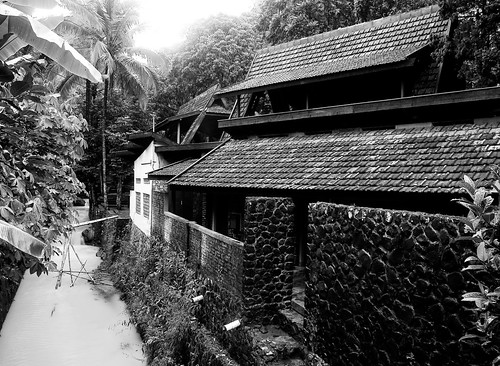
Its was somehow fortunate for us to visit the complex when it was drizzling. You could see the considerations Father Mangun had to topicality, specifically rainfall in the mountainous regions. The way detailed the over hanging roofs of his A-frame structures (of which is very identifiable in his other works like the library in Kampung Kali Chode). Considerations of drainage and leaf fall, you could see the reason why certain gaps were left between slabs or why certain roofs had to be pitched so high.
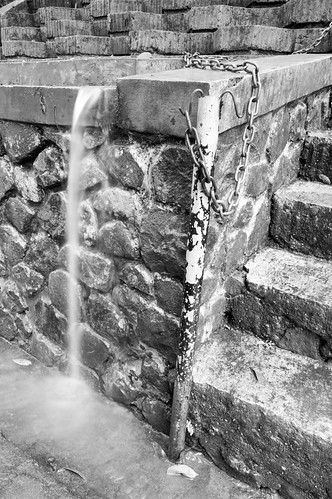

Father Mangun's approach somehow reminds me of the way Jean Prouvé constructed his home , the tectonics and indepth knowledge of local materials are clearly evident (of which Mr Eko's work is clearly influenced by). Stone walls, wooden frames, mass produced hexagon tiles. I especially enjoyed the geometry and manipulation of the hexagon tiles.
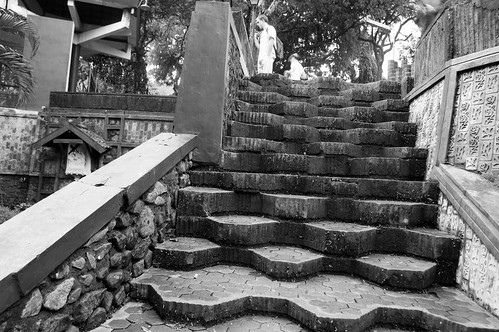
These geometric tiles were used as part of the retaining walls in hilly terrain.
It is such an elegant construction material, brilliantly used. On one hand it's used as a retaining wall on the other it also acts as a seat with a backrest and also a step (ala tango steps)
The nearby village sustains itself from selling rosaries and candles for visitors to Sendang Sono. Some stalls even sell empty bottles for visitors to collect holy water from the spring (which is now piped from a cleaner source upstream and not taken directly from the river at the complex). Many visitors, both local and abroad come here not only for pilgrimage but also to experience the tranquility and peace of such a sacred place.
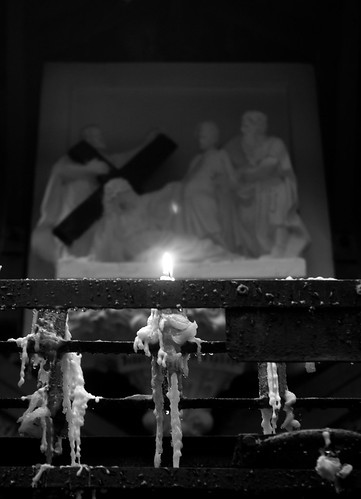
Each altar displays a story depicting the struggles of Christ.

The Cave of Mary. People light up candles and pray in front of her. They sometimes leave messages on paper and burn them in a burning pot.
Sendang Sono was my most memorable place in Jogja, yes it even beats Borobudor which to me somehow has been disneylanded into a national (some saw international) tourist attraction.
Here's abit about the now deceased Father Mangunwijaya (born Ambarawa, Semarang, 6 May 1929 - died in Jakarta 10 February 1999).
from wiki
"He is the son of Yulianus Sumadi and Serafin Kamdaniyah. At the age of sixteen, during the revolution for independence from the Dutch, he joined the Student Army. The troops' callousness towards the villagers shocked him. In 1950, after hearing a speech by Major Isman about the harmful effects of the revolution on civilians, he decided to repay his debt by serving the people as a priest. He was ordained as priest in 1959, upon completion of his study in Philosophy and Theological Institute Sancti Pauli in Yogyakarta. He continued to study architecture in Aachen, Germany, and Institute of Humanistic Studies, Aspen, Colorado."
Winner of the Aga Khan Award for Architecture in 1992 for the Kampung Kali Chode Urban Settlement (of which you can read more about in Huilian's blog) and also famous for his fiction works earning him a Golden Windmill Award for fiction literary works from Radio Nederland. The famous architect and tutor of Indonesia Mr Eko Prawoto (who teaches at UKDW) was once under his tutelage.
Sendang Sono was named by its location. Sendang means water spring and Sono means the sono or sonokeling tree, denoting that the spring is located under the sono tree. Its really amazing to see how Father Mangun managed to construct this on hilly terrain with the way he blended the structures with the natural elements. The river still flows naturally (and very beautifully), the sonokeling tree undisturbed and still growing strong, testament to how much respect Father Mangun had for the site.


Its was somehow fortunate for us to visit the complex when it was drizzling. You could see the considerations Father Mangun had to topicality, specifically rainfall in the mountainous regions. The way detailed the over hanging roofs of his A-frame structures (of which is very identifiable in his other works like the library in Kampung Kali Chode). Considerations of drainage and leaf fall, you could see the reason why certain gaps were left between slabs or why certain roofs had to be pitched so high.


Father Mangun's approach somehow reminds me of the way Jean Prouvé constructed his home , the tectonics and indepth knowledge of local materials are clearly evident (of which Mr Eko's work is clearly influenced by). Stone walls, wooden frames, mass produced hexagon tiles. I especially enjoyed the geometry and manipulation of the hexagon tiles.

These geometric tiles were used as part of the retaining walls in hilly terrain.
It is such an elegant construction material, brilliantly used. On one hand it's used as a retaining wall on the other it also acts as a seat with a backrest and also a step (ala tango steps)
The nearby village sustains itself from selling rosaries and candles for visitors to Sendang Sono. Some stalls even sell empty bottles for visitors to collect holy water from the spring (which is now piped from a cleaner source upstream and not taken directly from the river at the complex). Many visitors, both local and abroad come here not only for pilgrimage but also to experience the tranquility and peace of such a sacred place.

Each altar displays a story depicting the struggles of Christ.

The Cave of Mary. People light up candles and pray in front of her. They sometimes leave messages on paper and burn them in a burning pot.
Sendang Sono was my most memorable place in Jogja, yes it even beats Borobudor which to me somehow has been disneylanded into a national (some saw international) tourist attraction.

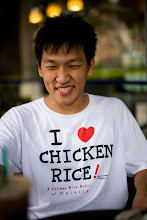




2 Comments:
I'm currently googling on Yousef Mangunwijaya, and have been really impressed by the results so far, particularly your photos of Sendang Sono complex. (I've been reading more about his Kampung Kali Cho-de). Gorgeous shots by the way. Thanks for inspiring me to take a trip to Jogja!
your welcome Lizard! yes Jogja is a wonderful place to visit and Father Mangunwijaya's work is most inspiring. DO check out Mr Eko PRawoto's work too, he brought us around Chode. I did a study on that area too. I'll post it soon on the blog. cheers
Post a Comment
<< Home